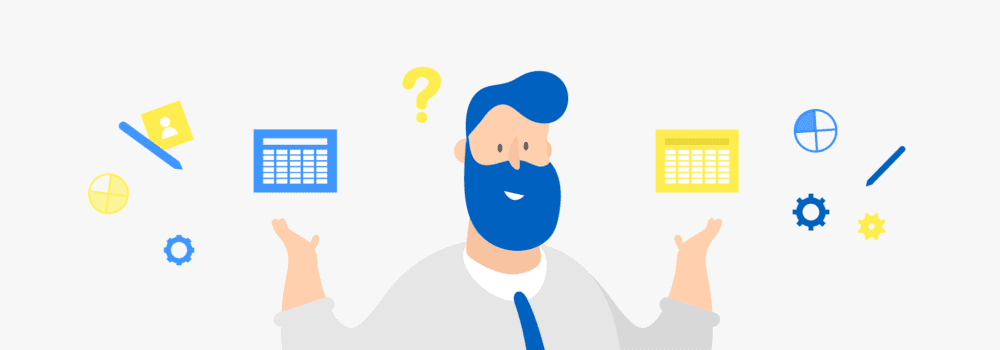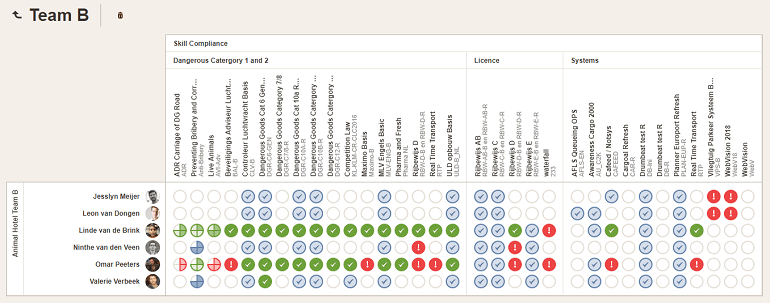Skills & competences: But what’s the difference?
Virtually every job description or job vacancy ad has them – a list of skills and competences the candidate needs to have to do a particular job properly. It’s interesting to note that the terms ‘skill’ and ‘competence’ are often used interchangeably despite there being a major difference between the two. We’ll be attempting to explain the difference between skills...

Virtually every job description or job vacancy ad has them – a list of skills and competences the candidate needs to have to do a particular job properly. It’s interesting to note that the terms ‘skill’ and ‘competence’ are often used interchangeably despite there being a major difference between the two.
We’ll be attempting to explain the difference between skills and competences in this blog post, as well as providing a few practical examples. What’s more, we’ll also show you how to map out and get to grips with your organization’s skills and competences.

What’s a ‘competence’?Copied
First, let’s define both terms so that we can better illustrate the difference between skills and competences.
competence – a combination of knowledge, skills, attitudes, and/or personal traits demonstrated in a person’s behavior that allows them to achieve specific objectives in a work-related setting
A competence essentially consists of three elements:
- knowledge: information and experience
- skills: highly developed physical and/or mental abilities and coordination required to perform a specific task
- attitudes/personal traits: a person’s values as they define them as an individual and how they relate to and interact with their surroundings
Competences – 10 examples
Perhaps you’re left feeling that the definition above is a little vague, theoretical, or abstract. So, let’s illustrate the term ‘competence’ further using a few examples. Here are ten for starters:
- Adaptability: an ability to act effectively even in the face of changing working conditions, tasks, and responsibilities
- Communicativeness: an ability to express oneself fully, both verbally and in writing, to formulate ideas clearly and concisely, and to communicate and present these to others.
- Engagement: a state of being whereby an individual feels connected to the task they are performing or a profession they practice, and in doing so have a positive effect on others around them.
- Collegiality: an ability to take into account the needs and interests of other people in an individual’s working environment.
- Rallying Ability: an ability to garner people’s support to achieve an objective or to bring about change, and to turn potential resistance to new plans or reforms into a positive force for change.
- Learning Ability: an ability to take on, analyze, and process new ideas quickly and easily, and to apply these immediately in a work setting.
- Networking Skills: an ability to establish, nurture, and cement working relationships, coalitions, and partnerships, both inside and outside the organization.
- Leadership: an ability to unify and steer a group of people, and to establish and maintain enduring partnerships.
- Resilience: an ability to perform effectively even under pressure and/or in the face of setbacks and opposition.
- Self-Reflection: an ability to see one’s strengths and weaknesses, convictions, qualities, ambitions, and interests.

What’s a ‘skill’?Copied
Although both terms are often used in the same context, there is a significant difference between a skill and a competence.
skill – an ability to perform a specific task or activity to a high level of proficiency
It’s possible to acquire and hone skills to perfection (or near enough) through practice and dedication. Learning and mastering a skill involves far more than just a theoretical understanding of facts or concepts.
Skills – 10 examples
There are many types of skill, and they can be categorized as practical, academic, or personal. Here are some examples.
- Bandaging: one of the tasks required to perform first aid or care for someone injured.
- Editing: the art of producing readable text and improving existing text.
- Listening: an ability to be patient and understand what someone else is trying to say or express.
- Sales: an ability to convince and persuade in a commercial setting.
- Drawing: a creative art rendering reality in pictorial form.
- Presentation: an ability to verbally convey general and specialist information to an audience – clearly, convincingly, and compellingly.
- Design: a creative art requiring spatial insight.
- Analysis: an ability to dissect problems or issues into bite-sized chunks to better understand the whole.
- Teaching: an ability to impart information or explain a concept to others.
- Programming: an ability to write logical code for creating computer software.
Skills & competences – the differenceCopied
The terms ‘skill’ and ‘competence’ are often used interchangeably, but in reality they’re quite different concepts.
The main difference is that a competence is far broader than a skill. A competence is a combination of knowledge, one or more skills, and certain attitudes or personal traits. Alert readers among you will have no doubt spotted that a skill is a subset of a competence. For example, as a competence, communicativeness requires several skills including listening, summarization, inquisitiveness, and persuasion.

Developing and improving skills and competencesCopied
I was speaking to the HR manager at a cheese factory recently. She was telling me how vital it was not only to identify skills and competences, but also to invest time and effort into developing and improving them. She maintained it had always paid off for her in the long term.
On asking her about her methods for honing her staff’s skills and competences, she gave me her top four tips.
1. Keep your eyes on the goal
Developing and improving competences starts with setting clear goals. You have to make it clear why it’s important to do so.
If your staff isn’t motivated to work on their skills and competences, or they’re uncertain why it’s worth their while, then you’re simply wasting your time and energy. And that would be a shame!
2. Nurture skills and competences
As a manager, you shouldn’t be restrictive about how you deal with skills and competences within your organization. Seek a balance between control and freedom and give your staff the space to do what they’re good at. Focus on their core competences and skills, and don’t overburden them with side-issues and restrictive dos and don’ts.
3. Keep training
As an employee, you can do a lot yourself to hone your skills and competences. For example, theoretical and/or practical training courses, work-study programs, internships, home study programs, classic-style schooling, coaching, mentoring, etc.
The most suitable method depends on your character and/or the type of skill you’re looking to acquire or hone. As an employer, you should encourage your staff to undertake some form of ongoing professional development by giving them or financing their training.
4. Don’t forget non-work-related competences
Non-work-related skills, competences, and qualities are also key to how someone functions and behaves on the work floor. Pay attention to these as they provide a complete picture of someone’s personality.
Mapping skillsCopied
It’s important to know which skills and competences exist within your organization. After all, knowing what your staff can and can’t do provides both valuable insights and potential benefits.
- For example, when you’re putting together a project team, how useful would it be to know exactly which skills and competences each staff member has?
- How about arranging replacements for staff off sick or away on vacation?
- What’s more, mapping out the skills and competences in your organization will also pinpoint any shortfalls. But once armed with this information, you’re in a position to take action – train existing staff or recruit new staff. Simple!
Skills matrices are useful tools for mapping all of your staff’s skills and competences. As their name suggests, they clearly and concisely provide a complete picture of all skills, competences, and qualifications in a matrix layout. The left-hand column lists all your staff members by name, and the top row lists the foremost skills they require to carry out a particular task. This is also helpful when competency mapping for specific roles.
Moreover, nothing is stopping you from flipping these around – tasks, jobs, or skills in the left-hand column and names along the top row. Next, it’s up to you to decide what system to use to record each staff member’s proficiency level – a score, a pie chart, or some other symbol.
Tip: If you’re curious about how skills matrices work in practice, take a look at our Five free skills matrix templates.

Maintaining clarityCopied
For years now, organizations have been creating skills matrices in spreadsheets, such as MS Excel. This is certainly an option, but not always the most useful or simplest way to do things. Spreadsheets soon become highly complex, unworkable in terms of version management, and extremely prone to error – in other words, pitfalls at every turn.
AG5’s skills management software solves these problems and automates many of the tasks that you have to perform manually when using spreadsheets. Special-purpose software provides so much more functionality and clarity about your staff’s current skills, competences, and qualifications:
- Enter proficiency updates and training results directly from the work floor
- Put together project teams explicitly based on the expertise and experience required for the task at hand
- Set up notifications for individual staff members, groups, or certification about to lapse or expire
- Identify the most qualified replacements for staff members off sick or away on vacation
- Replicate organizational structures and the relationships between staff members and qualifications
If you’re looking for the right tools to provide greater clarity about your staff’s skills and competences and to manage and maintain these quickly and easily, schedule a personal demo and dive into the world of AG5!
Use AG5 to identify skill gaps
Say goodbye to Excel matrices. Start using AG5’s plug and play skill matrix software.
ISO27001 certified
Free trial available
